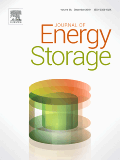
Aluminium is one of the promising negative electrode materials for modern batteries. It is environmentally abundant, affordable and recyclable, and its three-electron redox reaction offers high theoretical specific energy and power. However, the development of a suitable positive electrode continues to limit the practical performance of aluminium batteries. In this study, the application of a 3D conductive polymer poly(3,4-ethylenedioxythiophene) (PEDOT) as a potential positive electrode material is reported. The battery performance, C-rate versus capacity extraction and successive charge/discharge cycling of a full cell (aluminium (-); PEDOT (+); EMImCl-AlCl3 ionic liquid electrolyte) is investigated. The design of the PEDOT electrode (using 3D reticulated vitreous carbon as substrate) is studied, and is supported by microstructure characterisation. The aluminium-PEDOT battery provides 50–64 Wh kg−1 specific energy and 32–40 W kg−1 specific power. The battery has a coulombic efficiency >95%, stable operation over 100 cycles and charge rates up to 80C. In summary, direct and meaningful progress has been made towards achieving useful capacity and cycling stability from aluminium batteries intended for future energy storage.
Get funded, develop & make a difference!